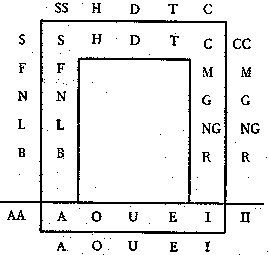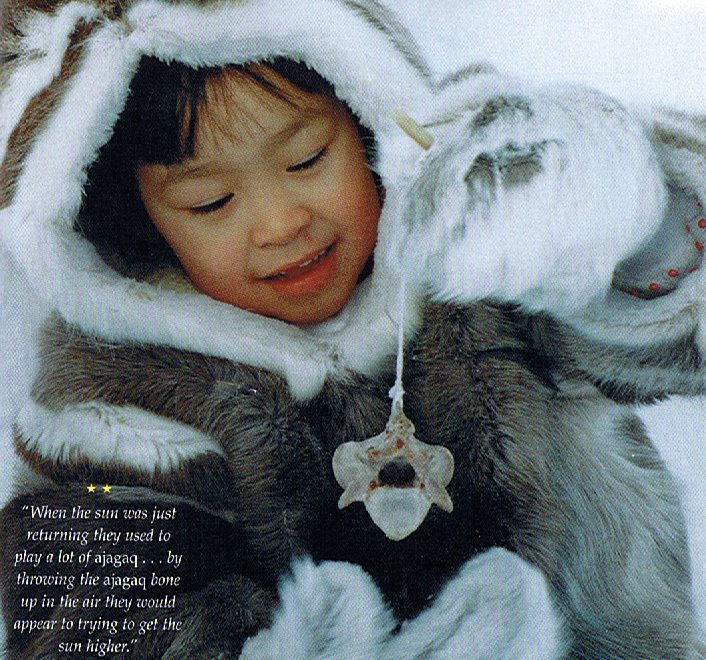|
TRANSLATIONS
I would like to continue the discussion by repeating what Graves suggested about Stonehenge: "The plan of the five dolmen corresponds exactly with the disc alphabet, since there is a broad gap between the two standing nearest to the avenue (like the gap which contains the five holy days of the Egyptian, or Etruscan, year) and between the gap and the avenue stood a group of four smaller undressed stones [i.e. A, O, E, I], corresponding with the groups of three stones in the inner horseshoe, but with a gap in the middle; and far back, in the avenue itself, the huge undressed 'Heel' stone [U] made a fifth and central one.
This is not to assume that Stonehenge was built to conform with the disc-alphabet. The calendar may have anteceded the alphabet by some centuries. All that seems clear is that the Greek alphabetic formula which gives the Boibel-Loth its letter-names is at least a century or two earlier than 400 B.C. when the Battle of the Trees were fought in Britain. The formula is plain. The Sun-god of Stonehenge was the Lord of Days, and the thirty arches of the outer circle and the thirty posts of the inner circle stood for the days of the ordinary Egyptian month; but the secret enclosed by the these circles was that the solar year was divided into five seasons, each in turn divided into three twenty-four-day periods, represented by the three smaller posts in front of the dolmens. For the circle was so sited that at dawn of the summer solstice the sun rose exactly at the end of the avenue in dead line with the altar and the Heel stone; while, of the surviving pair of four undressed stones, one marks the sun's rising at the winter solstice, the other its setting at the summer solstice." (The White Goddess) The list of (5 * 3 + 5 = 20) letters cannot be mapped onto the arches of stone (or onto the posts in the inner circle), because they were 30 in number. Yet there was a secret telling of 5 seasons in the year, corresponding to 3-letter groups, he says. The explanation Graves offers is rather weak: a) 'four undressed stones, one marks the sun's rising at the winter solstice, the other its setting at the summer solstice' b) 'at dawn of the summer solstice the sun rose exactly at the end of the avenue in dead line with the altar and the Heel stone'. So what? Are we to infer 5 (4 undressed stones + the dead line associated with the Heel stone) divisions of the year from that? The division of the year by 4, two straight lines intersecting the year into quarters, was the pattern of the Incas, according to the ceque pattern:
Each quarter should have 91 (= 7 * 13) days if 364 was to be reached. The ceque pattern has 9 (i.e. 32) lines for each quarter (except the last quarter with 14 lines). 27 (i.e. 33) + 14 = 41, after which next round starts with 42. But counting the number of letters (a, b, c) we find 27 + 15 (because line 8 in the 4th quadrant has both c and a (hidden inside). It reminds me of how Aa1-15 can be counted as two reaching 16. The symmetric behaviour of the sun as it moves in its yearly path does not lead to a divison of the year into 5 equal parts. 20, the number of letters, is easily explained as being equivalent to the number of fingers and toes. Though 15 for the consonants (and as a consequence 5 for the vowels) probably was because it takes the moon 15 nights to reach its maximum (Omotohi). 15 (the consonants) - ½ * 30 - probably was chosen to match the nights of waxing moon. "In Greece the metres allotted to the satirist were the poetic metres in reverse. Satire can be called left-handed poetry. The Moon travels from left to right, the same way as the Sun, but as she grows older and weaker rises every night a little farther to the left; then, since the rate of plant growth under a waxing moon is greater than under a waning moon, the right hand has always been associated with growth and strength but the left with weakness and decay. Thus the word 'left' itself means, in Old Germanic, 'weak, old, palsied'. Lucky dances by devotees of the Moon were therefore made right-handed or clockwise, to induce prosperity; unlucky ones to cause damage or death were made left-handed, or 'widdershins'. Similarly, the right-handed fire-wheel, or swastika, was lucky; the left-handed (adopted by the Nazis) unlucky. There are two sides to the worship of the Indian Goddess Kali: her right side as benefactress and universal mother, her left side as fury and ogress. The word 'sinister' has come to mean more than left-handed because in Classical augury birds seen on the left portended ill-luck." (The White Goddess) How Moon grows and decays probably was compared with how Sun increased and waned during the year. After reaching his maximum at midsummer he became weak and later 'dies'. Graves has another 'map' worthy of note:
The vowels are 'in the ground' (earth), while the consonant are in the air, equivalents to the building blocks in the arch of stone. Consonants are building blocks, while vowels are without conceptual meaning, they just make talking easier. This set of consonants has 13 elements (equal to the number of 4-week periods in a year). Though S and C can be counted twice, being corner stones, and then we reach 15. The shape of this stone dolmen is equivalent to the shape of Π. The circumference of the circle usually is taken as twice π times the radius. Equally well we could calculate with 6.28 times the radius, and define Π as twice π. The set of 13 consonants Graves maps unto the 28-night months of the year and from that several other correspondences may be listed, e.g. the tree calendar:
The importance of waxing moon and waxing sun for growing may explain the magic efforts undertaken by throwing thighs and other objects into the air. The Inuit people still have a children's game (ajagaq) remembering that:
'... by throwing the ajagaq bone up in the air they would appear to trying to get the sun higher'. I would therefore like to rewrite the 8-period 'calendar' at the beginning of side a of Tahua:
We do not see the shape of Π. Instead we see a gradually straight rising of the sun up to the apex at midsummer. The shape is similar to that of the roof in the Taranaki store house:
Counting number of heads we find 5 'in the ground', 3 in rising at left and 2 in descending at right. 5 + 3 + 2 = 10 (as the number of ana on Tahiti), 5 'vowels' and 5 'consonants'. 2 of the 'vowels' (left and right of the middle 'cat') are female, the rest (8) probably are male. Male means the sky in this frame of reference. The pattern, therefore, should be 3 ('in the ground') + 3 ('rising') and 3 ('waning'). One is missing. I guess he is represented by the egg to the right of the apex. Possibly this location corresponds to the Tavake place on Easter Island - with Kuukuu being the king loosing his head ('nut') at the apex. (... Ira spoke these words: 'This is the digging stick (? ko koko), Kuukuu. You shall work the land for me and plant the yam roots!' ...) You must break an egg to make an amulet. "Up to the present time, fertility spells for fowls have played an important role. Especially effective were the so-called 'chicken skulls' (puoko moa) - that is, the skulls of dead chiefs, often marked by incisions, that were considered a source of mana. Their task is explained as follows: 'The skulls of the chiefs are for the chicken, so that thousands may be born' (te puoko ariki mo te moa, mo topa o te piere) (Englert 1939:240). As long as the source of mana is kept in the house, the hens are impregnated (he rei te moa i te uha), they lay eggs (he ne'ine'i te uha i te mamari), and the chicks are hatched (he topa te maanga). After a period of time, the beneficial skull has to be removed, because otherwise the hens become exhausted from laying eggs." (Barthel 2) I suggest this perspective explains why the neck is 'cut' in Aa1-11:
|
||||||||||||||||||||||||||||||||||||||||||||||||||||||||||||||||||||||||||||||||||




